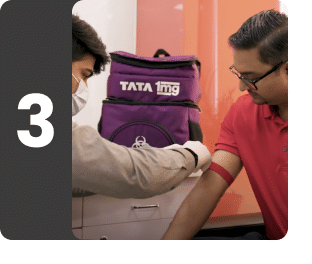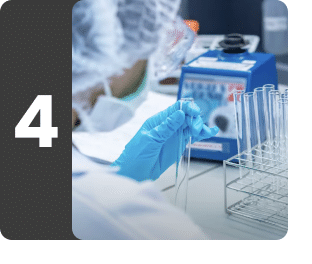Fever Panel for Influenza like Illnesses in New Delhi
Understanding Fever Panel for Influenza like Illnesses in New Delhi
What is Fever Panel for Influenza like Illnesses in New Delhi?
Fever Panel for Influenza-like Illnesses helps detect fever due to illnesses like influenza (flu) and COVID-19 infection. This package includes a range of tests such as influenza A virus test along with its subtypes H1N1 (swine flu) and H3N2, influenza B virus test, respiratory syncytial virus (RSV) test, COVID-19 test, complete blood count test, C-reactive protein test, liver function test, kidney function test, and urine test. You may need this package if you have symptoms like fever, cold, loss of smell, headache, body ache, and cough. These tests help identify the cause of fever or cough so that timely treatment can be started. Measures such as hand washing, wearing a mask, drinking plenty of fluids, and proper rest may help in a speedy recovery.
What does Fever Panel for Influenza like Illnesses measure?
Contains 58 tests
CBC (Complete Blood Count)
A CBC (Complete Blood Count) test evaluates red blood cells (RBCs), white blood cells (WBCs}, and platelets. Each of these blood cells performs essential functions–RBCs carry oxygen from your lungs to the various body parts, WBCs help fight infections and other diseases, and platelets help your blood to clot–so determining their levels can provide significant health information. A CBC test also determines the hemoglobin level, a protein in RBC that carries oxygen from the lungs to the rest of your body. Evaluating all these components together can provide important information about your overall health.
Know more about CBC (Complete Blood Count)
Absolute Lymphocyte Count
-
T lymphocytes (T cells): T cells control your body’s immune system response and directly attack and kill infected cells and tumor cells.
-
B lymphocytes (B cells): B cells make antibodies. Antibodies are proteins that target viruses, bacteria, and other foreign pathogens.
An Absolute Lymphocyte Count test measures the total number of lymphocytes in the blood. Lymphocytes are a type of white blood cells that play an important role in your immune system and help your body fight disease and infection. There are two main types of lymphocytes:
Lymphocytes help your immune system remember every antigen (a foreign substance) it comes in contact with. After an encounter, some lymphocytes turn into memory cells. When these memory cells run into an antigen again, they recognize it and quickly respond. It is also the reason why getting vaccinated helps prevent certain diseases.
Absolute Neutrophil Count
An Absolute Neutrophil Count test measures the percentage of neutrophils per microliter of blood. Neutrophils are a type of WBC and play an integral part in the body's immune system. They help fight off bacterial infections in the body by identifying and destroying foreign invaders, such as disease-causing microorganisms.
Differential Leukocyte Count
- Differential Eosinophil Count
- Differential Basophil Count
- Differential Neutrophil Count
- Differential Lymphocyte Count
- Differential Monocyte Count
There are five types of WBCs: neutrophils, lymphocytes, monocytes, eosinophils, and basophils. A Differential Leukocyte Count test measures the percentage of each type of WBC in the blood. Leukocytes or WBCs are produced in the bone marrow and defend the body against infections and diseases. Each type of WBC plays a unique role to protect against infections and is present in different numbers.
This further contains
Red Blood Cell Count
A Red Blood Cell Count test measures the total number of red blood cells in your blood. RBCs are the most abundant cells in the blood with an average lifespan of 120 days. These cells are produced in the bone marrow and destroyed in the spleen or liver. Their primary function is to help carry oxygen from the lungs to different body parts. The normal range of RBC count can vary depending on age, gender, and the equipment and methods used for testing.
Hb (Hemoglobin)
An Hb (Hemoglobin) test measures the concentration of hemoglobin protein in your blood. Hemoglobin is made up of iron and globulin proteins. It is an essential part of RBCs and is critical for oxygen transfer from the lungs to all body tissues. Most blood cells, including RBCs, are produced regularly in your bone marrow. The Hb test is a fundamental part of a complete blood count (CBC) and is used to monitor blood health, diagnose various blood disorders, and assess your response to treatments if needed.
Platelet Count
A Platelet Count test measures the average number of platelets in the blood. Platelets are disk-shaped tiny cells originating from large cells known as megakaryocytes, which are found in the bone marrow. After the platelets are formed, they are released into the blood circulation. Their average life span is 7-10 days.
Platelets help stop the bleeding, whenever there is an injury or trauma to a tissue or blood vessel, by adhering and accumulating at the injury site and releasing chemical compounds that stimulate the gathering of more platelets. A loose platelet plug is formed at the site of injury and this process is known as primary hemostasis. These activated platelets support the coagulation pathway that involves a series of steps, including the sequential activation of clotting factors; this process is known as secondary hemostasis. After this step, there is a formation of fibrin strands that form a mesh incorporated into and around the platelet plug. This mesh strengthens and stabilizes the blood clot so that it remains in place until the injury heals. After healing, other factors come into play and break the clot down so that it gets removed. In case the platelets are not sufficient in number or not functioning properly, a stable clot might not form. These unstable clots can result in an increased risk of excessive bleeding.
Total Leukocyte Count
A Total Leukocyte Count test measures the numbers of all types of leukocytes, namely neutrophil, lymphocyte, monocyte, eosinophil, and basophil, in your blood. Leukocytes or WBCs are an essential part of our immune system. These cells are produced in the bone marrow and defend the body against infections and diseases. Each type of WBC plays a unique role to protect against infections and is present in different numbers.
Absolute Basophil Count
An Absolute Basophil Count test measures the total number of basophils in the blood. Basophils are small, spherically-shaped cells that originate from bone marrow and make up almost 1% of the total white blood cells in the body. They attack a foreign substance and release proteins like histamine and heparin to destroy harmful substances, such as allergens, pathogens, or parasites. Histamine helps widen the blood vessels and make space for more immune cells to come to the site of infection or injury, whereas heparin acts as a blood-thinning agent and helps to avoid blood clotting at that site.
Absolute Monocyte Count
An Absolute Monocyte Count test measures the total number of monocytes in the blood. Monocytes are a type of WBC that originate from bone marrow and travel to different tissues via the blood. Once they are inside the tissue, these cells get converted to macrophages (a type of cell that digest harmful substances). Monocytes are the second line of defense mechanism of the human body after neutrophils. These cells are also responsible for the removal of injured or dead cells, microorganisms, and other insoluble particles from the blood.
Absolute Eosinophil Count
An Absolute Eosinophil Count test measures the number of eosinophils in the blood and provides important information about the functioning of the immune system. Eosinophils originate from bone marrow and have a lifespan of 8-18 hours. These cells are involved in fighting certain types of infections and responding to allergic reactions in the body. Other functions of these cells include movement to the inflammation areas, trapping substances, killing cells, and bactericidal and antiparasitic activities. They also help in the treatment of immediate allergic reactions and modulation of inflammatory responses. By measuring the number of eosinophils in the blood, this test provides important information about the functioning of the immune system.
Hematocrit
A Hematocrit test measures the proportion of red blood cells (RBCs) in your blood as a percentage of the total blood volume. It is a crucial part of a complete blood count (CBC) and helps in assessing your blood health. RBCs are responsible for carrying oxygen from the lungs to different parts of the body. The hematocrit test provides valuable information about your blood's oxygen-carrying capacity.
Higher-than-normal amounts of RBCs produced by the bone marrow can cause the hematocrit to increase, leading to increased blood density and slow blood flow. On the other hand, lower-than-normal hematocrit can be caused by low production of RBCs, reduced lifespan of RBCs in circulation, or excessive bleeding, leading to a reduced amount of oxygen being transported by RBCs. Monitoring your hematocrit levels is essential for diagnosing and managing various blood-related disorders.
Mean Corpuscular Volume
A Mean Corpuscular Volume test measures the average size of your red blood cells, which carry oxygen through your body. This test tells whether your RBCs are of average size and volume or whether they are bigger or smaller.
Mean Corpuscular Hemoglobin
An MCH test measures the average amount of hemoglobin in a single red blood cell (RBC). Hemoglobin is an iron-containing protein in RBCs, and its major function is to transport oxygen from the lungs to all body parts. This test provides information about how much oxygen is being delivered to the body by a certain number of RBCs.
Mean Corpuscular Hemoglobin Concentration
An MCHC test measures the average amount of hemoglobin in a given volume of RBCs. MCHC is calculated by dividing the amount of hemoglobin by hematocrit (volume of blood made up of RBCs) and then multiplying it by 100.
Mean Platelet Volume
An MPV test measures the average size of the platelets in your blood. Platelets are disk-shaped tiny cells originating from large cells known as megakaryocytes, which are found in the bone marrow. After the platelets are formed, they are released into the blood circulation. Their average life span is 7-10 days.
Platelets help stop bleeding whenever there is an injury or trauma to a tissue or blood vessel by adhering and accumulating at the injury site, and by releasing chemical compounds that stimulate the gathering of more platelets. After these steps, a loose platelet plug is formed at the site of injury, and this process is known as primary hemostasis. These activated platelets support the coagulation pathway that involves a series of steps including the sequential activation of clotting factors; this process is known as secondary hemostasis. After this, there is a formation of fibrin strands that form a mesh incorporated into and around the platelet plug. This mesh strengthens and stabilizes the blood clot so that it remains in place until the injury heals. After healing, other factors come into play and break the clot down so that it gets removed. In case the platelets are not sufficient in number or are not functioning properly, a stable clot might not form. These unstable clots can result in an increased risk of excessive bleeding.
PDW
A PDW test reflects variability in platelet size, and is considered a marker of platelet function and activation (clot formation in case of an injury). This marker can give you additional information about your platelets and the cause of a high or low platelet count. Larger platelets are usually younger platelets that have been recently released from the bone marrow, while smaller platelets may be older and have been in circulation for a few days. Higher PDW values reflect a larger range of platelet size, which may result from increased activation, destruction and consumption of platelets.
RDW CV
An RDW CV test which is part of red cell indices, helps identify characteristics of red blood cells. RDW (red cell distribution width) measures the variations in the sizes of red blood cells, indicating how much they differ from each other in a blood sample. RDW is expressed as RDW-CV, a coefficient of variation. A higher RDW may suggest more variation in red cell sizes, while a lower RDW indicates more uniform red cell sizes.

CRP (C-Reactive Protein) - Quantitative
A CRP test measures the levels of C-reactive protein in your body. This test helps detect the presence of inflammation in the body. It is a non-specific test as it cannot diagnose a condition by itself or determine its exact location or cause.
CRP is an acute phase reactant protein produced by the liver in response to an inflammation in the body. This inflammation may be due to tissue injury, infection, autoimmune diseases, or cancer. CRP levels are often increased before the onset of other symptoms of inflammation, such as pain, redness, fever, or swelling. These levels fall as the inflammation subsides.
Know more about CRP (C-Reactive Protein) - Quantitative

Urine R/M (Urine Routine & Microscopy)
A Urine R/M (Urine Routine & Microscopy) test involves gross, chemical, and microscopic evaluation of the urine sample.
-
Gross examination: It involves visually inspecting the urine sample for color and appearance. Typically, the urine color ranges from colorless or pale yellow to deep amber, depending on the urine’s concentration. Things such as medications, supplements, and some foods such as beetroot can affect the color of your urine. However, unusual urine color can also be a sign of disease.
In appearance, the urine sample may be clear or cloudy. A clear appearance is indicative of healthy urine. However, the presence of red blood cells, white blood cells, bacteria, etc., may result in cloudy urine, indicating conditions such as dehydration, UTIs, kidney stones, etc. Some other factors, such as sperm and skin cells, may also result in a cloudy appearance but are harmless.
-
Chemical examination: It examines the chemical nature of the urine sample using special test strips called dipsticks. These test strips are dipped into the urine sample and change color when they come in contact with specific substances. The degree of color change estimates the amount of the substance present. Some common things detected include protein, urine pH, ketones, glucose, specific gravity, blood, nitrites, and urobilinogen.
-
Microscopic examination: This involves the analysis of the urine sample under the microscope for casts, crystals, cells, bacteria, and yeast.
Know more about Urine R/M (Urine Routine & Microscopy)
Urine Glucose
Ketone
Nitrite
Colour
Appearance
Specific Gravity
Epithelial Cell
Casts
Crystals
Protein Urine
Ph for Urine
Urobilinogen

Coronavirus Covid-19 Test- RT-PCR
A Coronavirus Covid-19 Test- RT-PCR test is an ICMR (Indian Council of Medical Research) approved test that helps to identify coronavirus infection by detecting the presence of the genetic material of the virus (SARS-CoV-2) in the body. This test uses a real-time reverse transcription-polymerase chain reaction (rRT-PCR) method, the gold standard for detecting the presence of viruses.
A positive test result means the presence of an active COVID-19 infection. If you test positive, stay home, separate yourself from others, and keep in touch with your doctor. A negative test result indicates an absence of an active infection at the time of sample collection. However, it doesn't mean you are safe at any time. You can get infected with COVID-19 and spread the virus to others any time after testing. Continue to take measures to protect yourself and others from getting the infection.
Know more about Coronavirus Covid-19 Test- RT-PCR

LFT and KFT (Liver Function Test & Kidney Function Test)
An LFT and KFT (Liver Function Test & Kidney Function Test) measures the components contributing to liver and kidney health. LFT is a group of tests that evaluates the levels of enzymes, proteins, and bilirubin produced by the liver. These components help to understand overall liver health and detect possible liver diseases. KFT with electrolytes evaluates the health of your kidneys. This test checks various parameters, such as creatinine, urea, uric acid, and electrolytes (sodium, potassium, and chlorine). It also helps diagnose possible kidney disorders, such as inflammation, infection, or functional damage in the kidneys.
Know more about LFT and KFT (Liver Function Test & Kidney Function Test)
KFT with Electrolytes (Kidney Function Test with Electrolytes)
- Potassium
- Uric Acid
- Chloride
- Sodium
- Blood Urea Nitrogen (BUN)
- Serum Creatinine
A KFT with Electrolytes (Kidney Function Test with Electrolytes) test determines the health of your kidneys. It evaluates parameters such as creatinine, blood urea nitrogen (BUN), uric acid, and electrolytes (sodium, potassium, and chloride). This test also helps diagnose possible kidney disorders like inflammation, infection, or functional damage.
This further contains
LFT (Liver Function Test)
- Alkaline Phosphatase (ALP)
- SGOT
- SGPT
- Bilirubin Indirect
- Bilirubin Direct
- Gamma Glutamyl Transferase
- Bilirubin Total
- Protein Total, Serum
An LFT (Liver Function Test) helps determine the health of your liver by measuring various components like enzymes, proteins, and bilirubin. These components help detect inflammation, infection, diseases, etc., of the liver and monitor the damage due to liver-related issues.
This further contains

Viral Flu Panel (Influenza A&B, H3N2, H1N1, RSV) Qualitative RT-PCR
A viral flu panel tests for influenza A virus along with its subtypes H3N2 and H1N1 (swine flu), Influenza B virus, and respiratory syncytial virus (RSV). Viral flu spreads mainly through tiny droplets when an individual with flu coughs, sneezes, or talks. These droplets are dispersed into the air and can infect individuals in close proximity. Also, the virus can spread by touching surfaces that may have influenza viruses on them and then touching your nose, mouth, or eyes. This panel helps differentiate between different strains of influenza viruses and identifies RSV infection. Viral Flu Panel (Influenza A&B, H3N2, H1N1, RSV) Qualitative RT-PCR can be helpful during the flu season when there's a surge in various respiratory illnesses that show symptoms similar to the flu.
RNase P (IC) is an internal control used in the Viral Flu Panel (Influenza A&B, H3N2, H1N1, RSV) Qualitative RT-PCR. It ensures the accuracy and reliability of the test results by verifying suitable conditions for precise RNA analysis.
Know more about Viral Flu Panel (Influenza A&B, H3N2, H1N1, RSV) Qualitative RT-PCR
Influenza A
Influenza A checks for the presence of Influenza A virus and confirms the infection. Influenza A virus can infect both animals and humans and is responsible for most seasonal flu outbreaks. These viruses are further classified based on two proteins on their surface, called hemagglutinin (H) and neuraminidase (N). There are 18 different H subtypes and 11 different N subtypes, which can combine in different ways to create new strains of the virus.
Influenza B
Influenza B checks for the presence of the Influenza B virus and confirms the infection. This type of influenza virus only infects humans and is less common than influenza A. Influenza B viruses are not classified based on two proteins on the surface, called hemagglutinin (H) and neuraminidase (N) subtypes, but are instead grouped into two distinct lineages, B/Yamagata and B/Victoria.
Respiratory Syncytial Virus (RSV)
Respiratory Syncytial Virus (RSV) checks for the presence of Respiratory Syncytial Virus (RSV) and confirms the infection. This test should be performed within a few days after symptoms occur when there’s a greater detectable amount of the virus. RSV is a major cause of human respiratory infections, particularly among younger children who are affected most frequently with potentially most severe infections.
H1N1
H1N1 checks for the presence of the H1N1 virus, also called the swine flu (influenza) virus and confirms the infection. Influenza or flu is a viral infection that affects your respiratory system. The infection is usually mild and resolves on its own but in children aged below 5 years, adults above 65 years of age, and those with weakened immune systems, the infection can be life-threatening. Hence, early detection via timely testing becomes crucial.
H3N2
H3N2 checks for the presence of H3N2 virus and confirms the infection. The influenza A virus has a subtype known as H3N2, which can induce sickness in humans and animals such as pigs and birds. This particular strain of the flu virus is capable of causing illness. During the testing process, respiratory specimens such as nasopharyngeal swabs or nasal washes are analyzed to detect viral RNA or antigens.
Rnase P(IC)
The RNase P gene is used in the CDC (Centers for Disease Control and Prevention) protocol as an internal control (IC) for the detection of COVID-19, since this is a multi-copy gene that is abundant in the human genome, and therefore is easily detectable. Ribonuclease P (RNase P) is an endoribonuclease that cleaves other RNA molecules at the junction between a single-stranded region and the 5′ end of a double-stranded region. The enzyme is one of only two ribozymes that can be found in all kingdoms of life (Bacteria, Archaea, and Eukarya).
Book Fever Panel for Influenza like Illnesses at-home





Other tests









